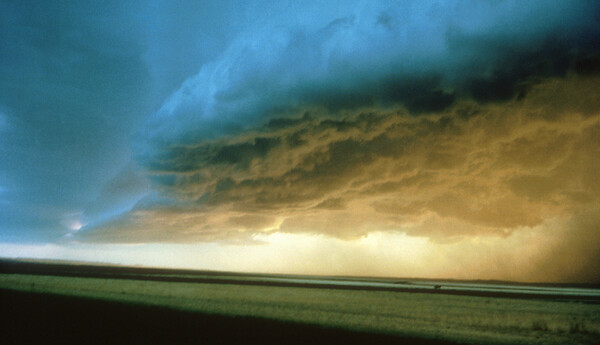뇌우 직선풍 증가로 광범위한 피해 일으켜…보험업계 연 25억 달러 피해 추정

미국 국립과학재단(National Science Foundation, NSF)이 지원하는 국립대기연구센터(NCAR)의 새로운 연구에 따르면, 미국 중부 지역의 뇌우에서 발생하는 파괴적인 바람은 기온이 따뜻해지면서 더욱 널리 퍼지고 있다.
『자연 기후 변화(Nature Climate Change)』 저널에 게재된 이 연구에 따르면, 지난 40년 동안 미국 중부 지역에서 뇌우 직선풍(Straight line winds)으로 인해 피해를 본 지역이 5배 증가했다.
이 연구는 기상 관측, 초고해상도 컴퓨터 모델링 및 기본 물리 법칙 분석을 결합해 바람의 변화를 추정했다. 바람의 변화는 너무 짧고 국지적이어서 기상 관측소에서 포착되지 않는 경우가 많았다.
이 연구는 NCAR의 후원사인 NSF와 매사추세츠 공과대학교(Massachusetts Institute of Technology) 기상과 기후 극단에 대한 기후 그랜드 챌린지(Climate Grand Challenge on Weather and Climate Extremes)의 자금 지원을 받았다.
이 연구의 저자이자 NCAR의 연구원인 안드레아스 프레인(Andreas Prein)은 "뇌우가 이러한 극단적인 강풍 현상을 점점 더 많이 일으키고 있다"며 "바람이 전혀 불지 않다가 시속 60~80마일의 돌풍으로 갑자기 변해 건물, 전력망, 심지어 사람의 안전을 위협할 수 있다"고 설명했다.
직선풍은 뇌우의 기저부에서 흐르는 강력한 하강기류에 의해 발생한다. 기상청은 이러한 바람이 50노트, 즉 시속 약 57마일을 초과하면 피해를 주는 것으로 분류한다. 보험 업계의 추정에 따르면, 이러한 바람은 미국에서 연간 약 25억 달러의 피해를 입힐 수 있다.
과학자들은 기후 변화가 직선풍에 미치는 영향에 대해 오랫동안 관심을 가져왔다. 그러나 지금까지 컴퓨터 모델에서 실행된 기후 조건 시뮬레이션은 이러한 짧고 작은 규모의 현상을 포착하기에는 한계가 있었다. 또한 기상 관측에 따르면 역설적으로 최대 풍속이 동시에 상승할 수 있음에도 불구하고 전 세계적으로 바람이 거의 불지 않거나 전혀 불지 않는 기간이 더 많았음을 나타냈다.
프레인 연구원은 NCAR 과학자들이 최근 미국 지질조사국(U.S. Geological Survey)과 협력해 제작한 고해상도 컴퓨터 모델 시뮬레이션을 통해 피해를 주는 직선풍이 더 널리 퍼지고 있는지 확인했다. CONUS404라고 명명된 이 고급 시뮬레이션은 지난 40여 년 동안 미 대륙을 걸쳐 4km(2.5마일)의 해상도로 기후와 수문학 조건을 시뮬레이션했다.
프레인 연구원은 세계적으로 직선풍이 가장 많이 발생하는 지역인 미국 중부의 여름철 기후 조건에 중점을 뒀다. 고해상도 모델링을 통해 이전 보다 훨씬 세밀한 바람의 사진을 확보할 수 있었으며, 분석도 기존 95개 기상 관측소에서 10만9천387의 시뮬레이션 지점으로 확장할 수 있었다. 시뮬레이션은 직선풍의 영향을 받는 지역이 지난 40년 동안 약 4.8배 증가했다는 것을 보여줬다.
프레인 연구원은 "이번 연구 결과에서 알 수 있듯이, 기후 변화에 대한 대비 전략을 세울 때 증가하는 직선풍의 위험을 통합해 인프라의 회복탄력성을 확보하는 것이 중요하다"고 강조했다.
[원문보기]
Damaging thunderstorm winds increasing in central U.S.
Analysis shows impact of climate change on outflow from thunderstorms
Destructive winds that flow out of thunderstorms in the central United States are becoming more widespread with warming temperatures, according to new research by the U.S. National Science Foundation-supported National Center for Atmospheric Research (NCAR).
The new study, published in Nature Climate Change, shows that the central U.S. experienced a fivefold increase in the geographic area affected by damaging thunderstorm straight line winds in the past 40 years. The research uses a combination of meteorological observations, very high-resolution computer modeling and analyses of fundamental physical laws to estimate the changes in the winds, which are so short-lived and localized that they often are not picked up by weather stations.
The work was funded by NSF, which is NCAR's sponsor, and by the Massachusetts Institute of Technology Climate Grand Challenge on Weather and Climate Extremes.
"Thunderstorms are causing more and more of these extreme wind events," said NCAR scientist Andreas Prein, the author of the study. "These gusts that suddenly go from no wind at all to gusts of 60 to 80 miles per hour can have very damaging impacts on buildings, power grids and even human safety."
Straight line winds are caused by powerful downdrafts that flow from the base of thunderstorms. The National Weather Service classifies such winds as damaging if they exceed 50 knots, or about 57 miles per hour. The winds likely cause about $2.5 billion in damage annually in the U.S., based on insurance industry estimates.
Scientists have long been interested in the impact of climate change on straight line winds. Until now, however, simulations of climate conditions run on computer models have been too coarse to capture such brief and small-scale events. Further clouding the picture, weather observations appear to show that there are more periods of little to no wind worldwide (a phenomenon known as global stilling), even though, paradoxically, maximum wind speeds can rise simultaneously.
To determine if damaging straight line winds are becoming more widespread, Prein turned to a high-resolution computer model simulation that NCAR scientists recently produced in collaboration with the U.S. Geological Survey. The advanced simulation, named CONUS404, simulates climate and hydrological conditions at a resolution of 4 kilometers (2.5 miles) across the continental U.S. over the past 40-plus years.
Prein focused on summertime conditions in the central U.S., a global hotspot for straight line winds. The high-resolution modeling enabled him to get a much more fine-grained picture of winds than relying on sparse atmospheric observations, and to expand his analysis from 95 weather stations to 109,387 points in the simulation. The simulation showed that the area affected by straight line winds has increased in the last 40 years by about 4.8 times.
"As these findings show, it is crucial to incorporate the increasing risk of straight line winds when planning for the impacts of climate change so we can ensure the future resiliency of infrastructure to this frequently neglected peril," Prein said.
[출처 = 미국 국립과학재단(NSF)(https://new.nsf.gov/news/damaging-thunderstorm-winds-increasing-central-us) / 2024년 1월 11일]
[번역 = 배민지 차장]

